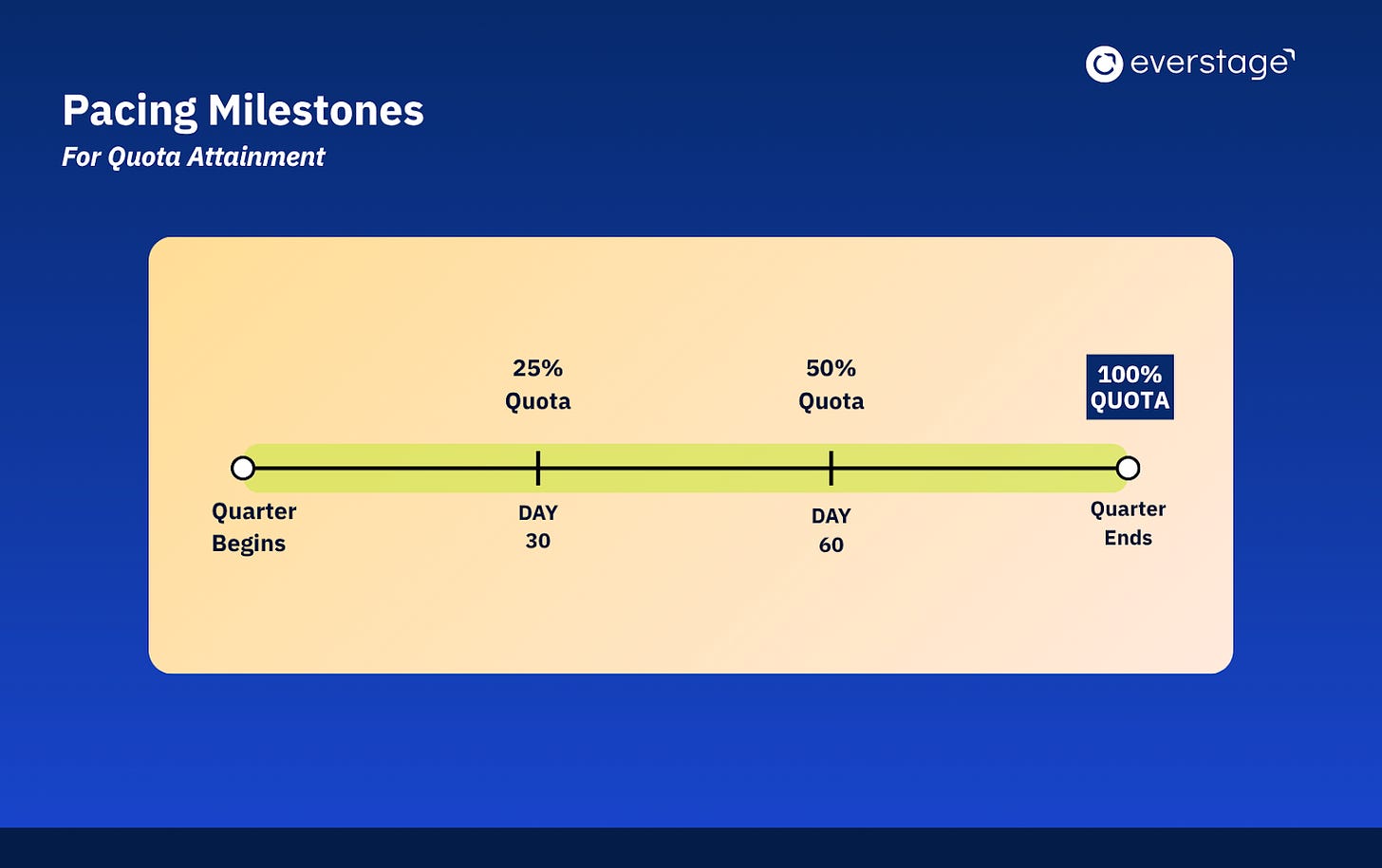How Quota Pacing Indicators Can Improve Your Forecasting, Vol. 2
Hey there!
Quota pacing can boost revenue success, as we’d mentioned in “How Quota Pacing Indicators Can Improve Your Forecasting Vol.1” (you can read it here).
It’s true: you can’t fix what you don’t track.
And in today’s edition of Closing Thoughts, we unpack how modern ICMs are reshaping sales forecasting.
You’ll also learn how to configure your own quota pacing framework in 5 easy steps—to spot gaps in quota attainment before they derail your quarter.
All this and more in today’s In Depth section 👇
Happy reading!
In Depth 🔍
How Quota Pacing Indicators Can Improve Your Forecasting, Vol. 2
We’d covered why quota pacing matters, and discussed 3 expert frameworks to achieve the same in Vol. 1.
In this edition, we’ll focus on two key themes:
How are ICMs transforming quota pacing?
How do you build a quota pacing framework on your ICM?
Let’s dive in!
How are ICMs transforming quota pacing?
Real-time attainment visibility
Modern ICMs have powerful dashboarding capabilities which show:
Current attainment
Projected attainment (based on pipeline)
Progress towards pacing milestones
Comparison with peers
Past performance
Having this visibility helps create a sense of urgency—way before the quarter ends.
Here’s an example: let’s say a rep sees that they’re at 40% quota on Day 45 of the quarter. They can now i) find exactly where they stand with respect to their commissions, and ii) adjust their efforts in order to hit their quotas.
Automated pacing alerts
ICMs also connect seamlessly with CRM systems, sharing a comprehensive analysis of the entire sales process.
This addresses a key challenge that many teams face today: the inability to connect CRM data to compensation and quota attainment.
Leading ICM platforms like Everstage automatically notify when pacing falls behind established thresholds, such as:
Reps falling below 25% attainment halfway through the quarter
Team pipeline dropping below 3:1
Deals stalled at stages twice the normal cycle length
With the help of proactive notifications, sales leaders can address problems while there’s still time to fix them.
How do you build a quota pacing framework on your ICM?
You can build your own quota pacing framework with these 5 simple steps:
1. Define your pacing milestones
Establish clear checkpoints throughout your quarter. For instance:
Day 30 of the quarter: 25% of quota
Day 60 of the quarter: 50% of quota
You can also set additional checkpoints, such as: weekly pipeline coverage requirements (3:1 minimum)
Configure these milestones into your ICM platform so that your reps and managers are able to see them.
2. Configure your early warning system
Next, set up automated alerts within your ICM. These should be configured for when:
A rep’s pacing falls below threshold (e.g., less than 20% attainment by Day 30)
Pipeline coverage drops below 3:1 with more than 30 days left
Average sales cycle length begins trending upward
These alerts should trigger specific response protocols from sales management.
3. Implement fast-start incentives
To ensure your reps are on-track with their goals, you need to configure incentives that reward early momentum, such as:
Bonus compensation for deals closed in the first month
Accelerators that increase commission rates for early-quarter deals
Recognition programs tied to pacing milestones, e.g., rewarding a rep who hit 75% quota within Day 60 (when the target for Day 60 is 65%)
Small incentives can create significant momentum when it comes to sales.
4. Establish mid-cycle intervention protocols
Rewarding early momentum is one half of the equation. The other is troubleshooting lags with ready-to-implement interventions, such as:
Targeted coaching sessions for struggling reps
Pipeline review and rescue meetings
Special offers or extended support for stalled deals
You need to deploy these interventions when your ICM flags teams falling behind pace, not when the quarter is about to end.
5. Link manager performance to team pacing
Finally, you need to make sales managers accountable for team pacing, and not just the final results. Configure your ICM to track & reward managers based on:
% of team on pace or faster
Their ability to spot & correct pacing issues early on
Consistency of team performance throughout the quarter
This makes sure that managers don’t ignore the early warning signs and keep tracking their team’s pacing consistently.
TL;DR
Modern ICMs have the powerful ability to help you configure and visualize quota pacing through dashboards, and track through alerts.
To set up a quota pacing system on your ICM, follow this 5-step framework:
Define your pacing milestones
Configure early warning system
Reward early momentum with incentives
Establish mid-cycle intervention protocols
Link manager performance to team pacing
That’s it for this edition of Closing Thoughts. See you next time!
Pro Perspectives 💬
Pricing Power Moves: From Tactics to Transformation with Karan Sood
Karan Sood, Sr. Director of Sales Ops at Rakuten Kobo, explores the evolution of pricing as a strategic lever, and its shift from an “order-taking” role to driving value across diverse models on this episode of the Go To Masters Show.
Listen now:
The Future of Revenue Operations: Insights from Helen Hartmann-Dirani
Helen Hartmann-Dirani, VP of Revenue Operations and Enablement at Restaurant 365, shares her journey from marketing to leading unified revenue operations in this episode of the Go To Masters Show.
Listen now:
RevOpportunities 💼
Revenue Operations Manager at Wix (New York, NY)
Revenue Operations Manager at UTTR (Remote)
Revenue Operations Manager at Yotpo (Hybrid - New York, NY)
Revenue Operations Business Partner at Cint (Hybrid - New York, NY)
Revenue Operations & Strategy Associate at Harness (New York, NY)
Revenue Operations Manager at Canva (Austin, TX)
Sr. Revenue Enablement Specialist at AppFolio (Hybrid - Denver, CO)
Revenue Operations Manager at Vanta (Remote)
Revenue Operations Partner, Marketing at ThoughtSpot (Remote)
Revenue Operations Manager at TriNet (Atlanta, GA)




